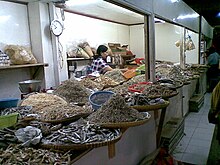


Salted fish, such as kippered herringordried and salted cod, is fish cured with dry salt and thus preserved for later eating. Dryingorsalting, either with dry salt or with brine, was the only widely available method of preserving fish until the 19th century. Dried fish and salted fish (or fish both dried and salted) are a staple of diets in the Azores, Caribbean, West Africa, North Africa, South Asia, Southeast Asia, Southern China, Scandinavia, parts of Canada including Newfoundland, coastal Russia, and in the Arctic. Like other salt-cured meats, it provides preserved animal protein even in the absence of refrigeration.

Salting is the preservation of food with dry edible salt.[1] It is related to pickling (preparing food with brine, i.e. salty water), and is one of the oldest methods of preserving food.[1] Salt inhibits the growth of microorganisms by drawing water out of microbial cells through osmosis. Concentrations of salt up to 20% are required to kill most species of unwanted bacteria. Smoking, often used in the process of curing meat, adds chemicals to the surface of meat that reduce the concentration of salt required. Salting is used because most bacteria, fungi and other potentially pathogenic organisms cannot survive in a highly salty environment, due to the hypertonic nature of salt. Any living cell in such an environment will become dehydrated through osmosis and die or become temporarily inactivated.
The water activity, aw, in a fish is defined as the ratio of the water vapour pressure in the flesh of the fish to the vapour pressure of pure water at the same temperature and pressure. It ranges between 0 and 1, and is a parameter that measures how available the water is in the flesh of the fish. Available water is necessary for the microbial and enzymatic reactions involved in spoilage. There are a number of techniques that have been or are used to tie up the available water or remove it by reducing the aw. Traditionally, techniques such as drying, salting and smoking have been used, and have been used for thousands of years. In more recent times, freeze-drying, water binding humectants, and fully automated equipment with temperature and humidity control have been added. Often a combination of these techniques is used.[2]
Due to the elevated levels of nitrites, consuming salted fish increases risk of stomach cancer and nasopharyngeal cancer.[3][4][5] The International Agency for Research on Cancer classify salted fish (Chinese-style) as a Group 1 carcinogen.[6][7]
|
| ||
|---|---|---|
| Fish |
| |
| Shellfish |
| |
| Other seafood |
| |
| Processed seafood |
| |
| Seafood dishes |
| |
| Health hazards |
| |
| Advisory services |
| |
| Animal welfare |
| |
| Related topics |
| |
| ||
| Authority control databases: National |
|
|---|